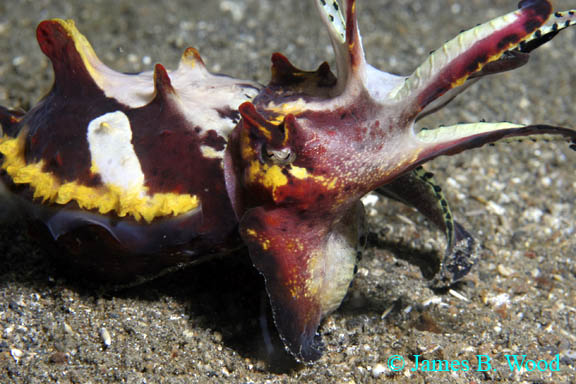
 |
| Home | What's New? | Cephalopod Species | Cephalopod Articles | Lessons | Bookstore | Resources | About TCP | FAQs |
Metasepia pfefferi<< Cephalopod Species
Members of the genus Metasepia are among the most visually striking cephalopods. Taxonomically, they are characterized by a thick small diamond shaped cuttlebone. The type specimen was collected off Challenger Station 188 in 1874 and is kept in the collections at The Natural History Museum in London. They mate in the head to head position and females lay their eggs on the underside of rocks, corals or coconut shells. Metasepia pfefferi is found in shallow (3 to 86 m) waters from Indonesia, to Papua New Guinea to the north shore of Australia, South Queensland to Western Australia. They are typically found ambling along (see below) on mud, sand or low energy coral rubble bottoms. In the summer of 2006 three of us, the founders of MarineBio.org headed to Indonesia. I was there for three weeks specifically to observe and photograph cephalopods. During this trip, despite many dives, I was able to find and photographed only two of these amazing animals. These remarkable cephalopods are active during the day. They slowly “walk” across the seafloor using their arms and flaps on their mantle; this type of locomotion has been called “ambling”. Normally camouflaged, the beautiful colors that give this cephalopod its common name are warning colors and are displayed when the animal is disturbed, See this video. Recently, scientists discovered that these warning colors are not a bluff, the animal is indeed toxic. Due to their beautiful coloration and interesting behavior, these cuttlefish demand a premium in the aquarium trade. However, unlike Sepia species, Metasepia pfefferi has never been raised in captivity although a related species, M. tullberghi has. Additionally, they are easy to catch once located but don’t appear to be common. For these reasons and their potential toxicity, I advise against keeping them in home aquaria. Sepia species are a much better alternative; some species of Sepia have been raised for over ten generations in captivity. ReferencesNorman, M 2003. Cephalopods a World Guide. Conch Books320 pgs.Roper, CFE; Hochberg, FG 1988 Behavior and systematics of cephalopods from Lizard Island, Australia, based on color and body patterns. Malacologia.
| ||||||
| Home | What's New? | Cephalopod Species | Cephalopod Articles | Lessons | Resources | About TCP | FAQs | Site Map | |
 |
The Cephalopod Page (TCP), © Copyright 1995-2026, was created and is maintained by Dr. James B. Wood, Associate Director of the Waikiki Aquarium which is part of the University of Hawaii. Please see the FAQs page for cephalopod questions, Marine Invertebrates of Bermuda for information on other invertebrates, and MarineBio.org and the Census of Marine Life for general information on marine biology. |